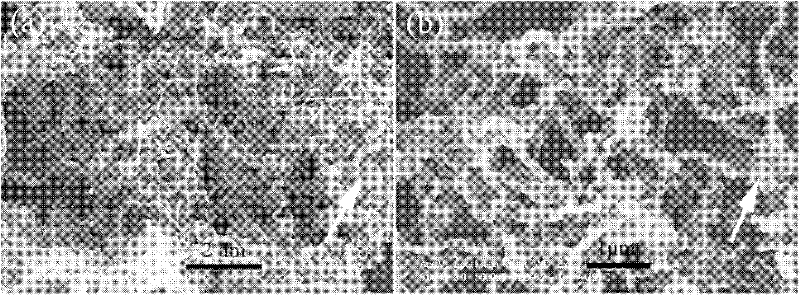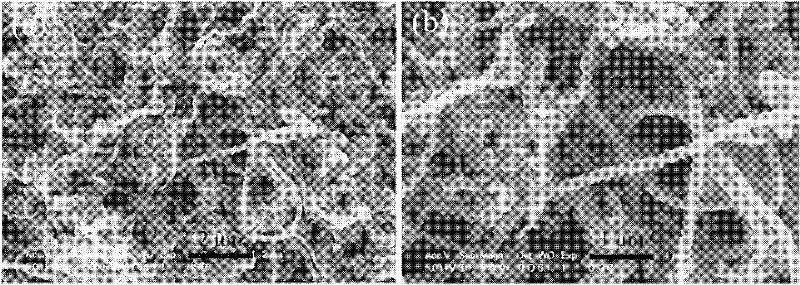Method for catalyzing and synthesizing spiral carbon nano material by using water-soluble alkali metal carbonate
A technology of alkali metal carbonate and carbon nanomaterials, applied in chemical instruments and methods, nanotechnology, physical/chemical process catalysts, etc. structure and other problems, to achieve the effect of saving raw material costs, saving purification costs, and being conducive to large-scale production
- Summary
- Abstract
- Description
- Claims
- Application Information
AI Technical Summary
Problems solved by technology
Method used
Image
Examples
Embodiment 1
[0020] step 1 Weigh 0.05 mol NaOH (solid), 0.05 mol KOH (solid) and 0.05 mol citric acid dissolved in 200 mL absolute ethanol, at 60 ° Continue stirring for 6 hours at C temperature to form a uniform transparent sol; 80 o C is evaporated and dehydrated until white powder; the powder is placed in a muffle furnace under an air atmosphere at 600 o C was precalcined for 4 hours to obtain a catalyst precursor.
[0021] step 2 Weigh 0.10 g of the catalyst precursor and spread it flat in a ceramic ark with a width of 3 cm and a length of 6 cm. Place the ark in a quartz reactor with an inner diameter of 6cm and a length of 80cm, and then place the quartz reactor horizontally in the tube furnace so that the ark is just placed in the middle of the tube furnace (where the thermocouple for temperature measurement is located).
[0022] step 3 Helium was introduced into the reactor to 5 ° The temperature was raised to 450 °C at a rate of C / min, and the temperature was maintained ...
Embodiment 2
[0026] step 1 Same as embodiment 1, step 1.
[0027] step 2 Same as embodiment 1, step 2.
[0028] step 3 Helium was introduced into the reactor to 5 ° The temperature was raised to 400 °C at a rate of C / min, and the temperature was maintained for 1 hour. The hydrogen gas was turned off, and the acetylene gas was switched immediately, and the reaction was carried out at 400 °C for 6 hours. Get a lot of black spiral carbon nanomaterials in the ark. The appearance of the product is attached figure 2 .
[0029] Substituting the absolute ethanol in step 1 for isopropanol gave similar results.
[0030]Similar results were obtained by replacing 0.05 mol NaOH (solid) and 0.05 mol KOH (solid) in step 1 with 0.02 mol NaOH (solid base) and 0.02 mol KOH (solid).
[0031] NaOH or KOH solution with mass concentration above 95% can also be used as raw material.
Embodiment 3
[0033] step 1 Same as embodiment 1, step 1.
[0034] step 2 Same as embodiment 1, step 2.
[0035] step 3 Helium was introduced into the reactor to 5 ° The temperature was raised to 500 °C at a rate of C / min, and the temperature was maintained for 1 hour. The hydrogen gas was turned off, and the acetylene gas was switched immediately, and the reaction was carried out at 500 °C for 6 hours. Get a lot of black spiral carbon nanomaterials in the ark. The appearance of the product is attached image 3 .
PUM
| Property | Measurement | Unit |
|---|---|---|
| diameter | aaaaa | aaaaa |
| diameter | aaaaa | aaaaa |
| length | aaaaa | aaaaa |
Abstract
Description
Claims
Application Information
 Login to View More
Login to View More - R&D
- Intellectual Property
- Life Sciences
- Materials
- Tech Scout
- Unparalleled Data Quality
- Higher Quality Content
- 60% Fewer Hallucinations
Browse by: Latest US Patents, China's latest patents, Technical Efficacy Thesaurus, Application Domain, Technology Topic, Popular Technical Reports.
© 2025 PatSnap. All rights reserved.Legal|Privacy policy|Modern Slavery Act Transparency Statement|Sitemap|About US| Contact US: help@patsnap.com



